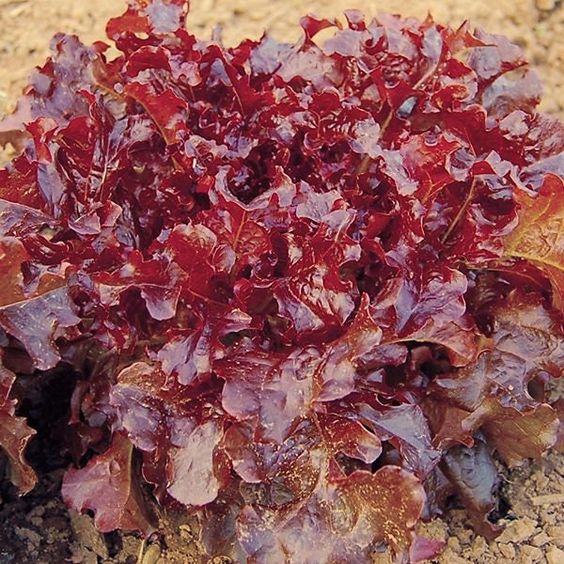Red Lettuce Seeds
Red Lettuce Seeds
Couldn't load pickup availability
Vibrant and Nutritious Red Lettuce Seeds for Your Garden
Germination Time: 7-14 days
Hours of Sunlight: 6-8 hours per day, in full sun
Ideal Climate for Sowing: Cool weather crop, best grown in spring and fall
Plant Height: 8-12 inches
Organic Fertilizer Requirement: 1 cup of compost or well-rotted manure per plant every 2-3 weeks
Life Span: 2-3 months
Ideal Growing Temperature: 15-20°C (60-70°F)
Harvesting Time: 45-60 days after sowing
Maintenance Required: Low
Ideal Grow Bag Size: 12x12 inches, 12x24 inches, or larger for higher yields
Specifications of Red Lettuce Seeds
Red lettuce, with its stunning deep color and crisp texture, is a nutrient-rich leafy green that's not only easy to grow but also adds a vibrant touch to salads and dishes. Particularly well-suited for Indian climates, it thrives in various growing conditions, making it a fantastic choice for gardeners of all experience levels.
Benefits / Uses of Red Lettuce
Packed with vitamins A and K, folate, and antioxidants, red lettuce is a delicious and healthy addition to any meal. Its unique flavor profile enhances salads, sandwiches, and wraps, providing both nutrition and aesthetic appeal. By growing your own, you ensure a fresh supply of this vibrant green.
Planting and Care for Red Lettuce
Each red lettuce seed holds the potential for beautiful, crisp leaves. When nurtured with care, they sprout into healthy plants ready to provide you with nutritious greens.
Sowing Red Lettuce Seeds
Sow seeds in moist, well-draining soil, approximately 1/4 inch deep. For improved germination, pre-soak the seeds in water for a few hours before planting.
Growing Red Lettuce
Red lettuce thrives in cooler temperatures and requires consistent moisture. Regular watering is essential to keep the soil evenly moist, but be careful not to overwater. Use grow bags with drainage holes to avoid excess moisture. Shield seedlings from harsh sunlight until they establish themselves fully. Mature plants typically reach heights of 8-12 inches.
Harvesting Red Lettuce
You can begin harvesting red lettuce once the leaves are sufficiently large, generally 45-60 days after sowing. You can either cut individual leaves or remove the entire plant, depending on your preference.
Precautions While Growing Red Lettuce
Red lettuce flourishes best in loamy, nutrient-rich soil with good drainage. The ideal pH range is between 6.0 and 7.0. Proper spacing is crucial to maintain airflow and mitigate disease risk.
Common Problems Affecting Red Lettuce Plants and Solutions
Red lettuce can face pests like aphids, slugs, and snails. Regular monitoring and the application of organic pesticides can help manage these pests effectively. Maintaining good airflow around plants helps prevent fungal diseases, while crop rotation and companion planting promote healthy soil.
Other Names for Red Lettuce
- Botanical Name: Lactuca sativa
- Tamil: செம்மல்லி (Semaḷḷi)
- Malayalam: ചുവപ്പു കൊൽ (Chuvappu kol)
- Kannada: ಕೆಂಪು ಹುಣಸು (Keṃpu hunaḍu)
- Telugu: ఎరుపు కరకండ (Erupu karakanda)
- Marathi: लाल सलाड पानं (Lāla salāḍ pānaṃ)
- Hindi: लाल सलाद पत्ता (Lāl salād pattā)
- Bengali: লাল লেটুস (Lal leṭus)
Red lettuce is a beautiful, versatile leafy green that’s not only easy to grow in a variety of conditions but also a delightful and nutritious addition to your home garden!
FAQ about Red Lettuce Seeds
1. How long does it take for red lettuce seeds to germinate?
Red lettuce seeds typically germinate within 7-14 days, depending on the temperature and moisture levels.
2. What is the best time to plant red lettuce?
Red lettuce thrives in cooler weather, making spring and fall the optimal seasons for planting in India.
3. How often should I water my red lettuce plants?
Water regularly to keep the soil evenly moist, typically every few days, especially during dry spells, but avoid overwatering.
4. Can I grow red lettuce in containers?
Absolutely! Red lettuce grows well in containers and grow bags, making it ideal for small gardens or balconies.
5. What should I do if my red lettuce leaves start to wilt?
Wilting may indicate either underwatering or overwatering. Check the soil moisture and adjust your watering schedule accordingly.
Product features
Product features
Materials and care
Materials and care
Merchandising tips
Merchandising tips
Share


